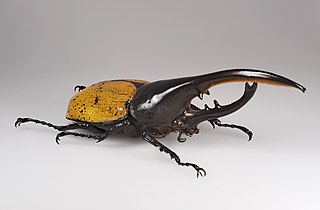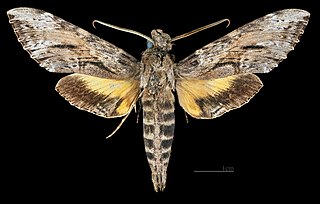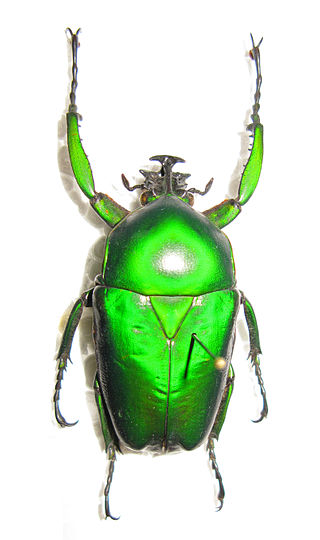
The family Scarabaeidae, as currently defined, consists of over 35,000 species of beetles worldwide; they are often called scarabs or scarab beetles. The classification of this family has undergone significant change. Several groups formerly treated as subfamilies have been elevated to family rank, and some reduced to lower ranks. The subfamilies listed in this article are in accordance with those in Catalog of Life (2023).

The Hercules beetle is a species of rhinoceros beetle native to the rainforests of southern Mexico, Central America, South America, and the Lesser Antilles. It is the longest extant species of beetle in the world, and is also one of the largest flying insects in the world.

The Japanese rhinoceros beetle, also known as the Japanese rhino beetle, the Japanese horned beetle, or by its Japanese name kabutomushi, is a species of rhinoceros beetle. They are commonly found in continental Asia in countries such as China, the Korean peninsula, Japan, and Taiwan. In these areas, this species of beetle is often found in broad-leaved forests with tropical or sub-tropical climates. This beetle is well known for the prominent cephalic horn found on males. Male Japanese rhinoceros beetles will use this horn to fight other males for territory and access to female mating partners. Upon contact, males will attempt to flip each other onto their backs or off of their feeding tree. In response to selective pressures, smaller male A. dichotoma have adapted a "sneak-like behavior". These smaller beetles will attempt to avoid physical confrontation with larger males and try to mate with females.

The Goliath beetles are any of the six species in the genus Goliathus. Goliath beetles are among the largest insects on Earth, if measured in terms of size, bulk and weight. They are members of subfamily Cetoniinae, within the family Scarabaeidae. Goliath beetles can be found in many of Africa's tropical forests, where they feed primarily on tree sap and fruit. Little appears to be known of the larval cycle in the wild, but in captivity, Goliathus beetles have been successfully reared from egg to adult using protein-rich foods, such as commercial cat and dog food. Goliath beetles measure from 60–110 millimetres (2.4–4.3 in) for males and 50–80 millimetres (2.0–3.1 in) for females, as adults, and can reach weights of up to 80–100 grams (2.8–3.5 oz) in the larval stage, though the adults are only about half this weight. The females range from a dark chestnut brown to silky white, but the males are normally brown/white/black or black/white. Goliath beetles, while not currently evaluated on the IUCN Red List, are facing growing conservation challenges across their African range due to habitat loss, over-collection for the international pet trade, and the potential impacts of climate change.

Smerinthus saliceti, the Salicet sphinx, is a moth of the family Sphingidae. The species was first described by Jean Baptiste Boisduval in 1875.

Isognathus rimosa, the rimosus sphinx, is a moth of the family Sphingidae. The species was first described by Augustus Radcliffe Grote in 1865.

Smerinthus ocellatus, the eyed hawk-moth, is a European moth of the family Sphingidae. The species was first described by Carl Linnaeus in his 1758 10th edition of Systema Naturae.

Goliathus cacicus, the chief goliath, is a species of beetles of the family Scarabaeidae.

Goliathus goliatus is a very large species of beetle of the family Scarabaeidae, native to tropical Africa.

Goliathus orientalis is a species of beetles belonging to the family Scarabaeidae.

Goliathus regius, the Royal Goliath beetle, is a species of beetles of the family Scarabaeidae.

Xylotrupes gideon, the brown rhinoceros beetle, is a species of large scarab beetle belonging to the subfamily Dynastinae.

Heliocopris is a genus of Scarabaeidae or scarab beetles in the superfamily Scarabaeoidea. Forty-seven of the fifty-two known species are found in Africa, but a few are found in southern and southeast Asia.

Dicronorhina micans is a species of beetle of the family Scarabaeidae and subfamily Cetoniinae. It is native to the African tropics.

Ecclitica torogramma, also known as the ponga ugly nestmaker, is a species of moth of the family Tortricidae. It is endemic to New Zealand.

Coprophanaeus ensifer is a large South American species of beetle belonging to the family Scarabaeidae. This species is necrophagous and builds burrows near or on animal carcasses to dismember the flesh of decaying bodies and bring it to its burrow to feed. Both females and males help build the burrow and feed. It is characterized by its iridescent colors and a horn that is similar in shape and size in females and males. It uses its horn to tear apart carcasses and to fight with other individuals, with male-male fighting occurring more often. However, females also fight to determine a variety of characteristics of the opposing male. This species may be of importance in forensic science due to its destructive behavior on decaying bodies, especially in areas of Brazil where homicide rates are high.

Rhinocoeta is a genus of colorful beetles belonging to the subfamily Cetoniinae, family Scarabaeidae.

Digitonthophagus bonasus, is a species of dung beetle found in India, Sri Lanka, Pakistan, Nepal, Myanmar, Thailand, Afghanistan, Vietnam and Cambodia.

Onthophagus luridipennis, is a species of dung beetle found in India, Sri Lanka, Thailand, and Indonesia.

Chrysorthenches phyllocladi is a species of moth in the family Plutellidae. It was first described by John S. Dugdale in 1996. It is endemic to New Zealand and has been observed in both the North and South Islands. The larvae of this species feed on Phyllocladus alpinus. Adults have been observed on the wing in February, April and November.






















